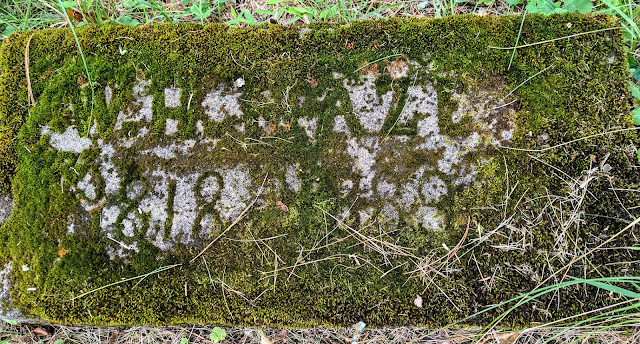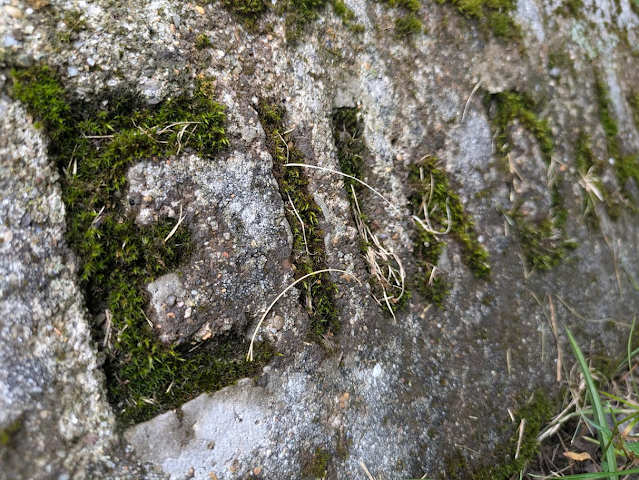One of the things I was very tuned in to during our summer visit to Cook Forest was moss. So much moss! Someday I'd like to take a class in bryology to understand more about it. I do know, for instance, that mosses have no roots, thus deriving everything they need from the air and surface water that accumulates on them. But other than being familiar with a few sphagnum mosses and temperate woods varieties, I feel like there's a whole universe of mossy knowledge out there I am craving.
 |
| Cooksburg Cemetery |
My first foray into the literature of moss was to read Robin Wall Kimmerer's Gathering Moss (2003). Kimmerer writes from the vantage point of a young bryologist who, like many of us, notices the wonderous close-at-hand by simply exploring the woods beyond her cabin home. We needn't go far to be lured into the world of bryology. But most importantly, she makes the connections between the worlds of moss and the worlds of people. She stresses science and folk/indigenous wisdom simultaneously, drawing us into very familiar yet alien landscapes of the small and magnificent.
There is an ancient conversation going on between mosses and rocks, poetry to be sure. About light and shadow and the drift of continents. This is what has been called the "dialect of moss on stone - an interface of immensity and minuteness, of past and present, softness and hardness, stillness and vibrancy, yin and yan. - RWK Gathering Moss
 |
| Cooksburg Cemetery |
 |
| Drake Well Museum, Oil City |
Revered bryologist and northern woods naturalist Jerry Jenkins, a founder of the Northern Forest Atlas Project (see Notes), explains that groups of mosses can be sorted by the surfaces they find most agreeable. There are groups for temperate forests and for boreal forests. There are moss maps that describe moss groups most likely found on permeable or non-permeable surfaces. There are moss groups for seepages, fens, temporary pools, sand, gravel, burnt ground, biocrusts, pavement, masonry, and bare rock. There are moss groups for marshy hummocks, soil banks, and xeric ridges and crests. There are mosses found only on unshaded sites and mosses found only on deeply shaded streambanks.
 |
| Beartown Rocks, Clear Spring State Forest |
Jenkins points out, however, that as a "supergroup" of living organisms found all over the world except for Antarctica, they are vulnerable to many threats and that we shouldn't take any of our mossy landscapes for granted. Climate disruption, fire, development and habitat loss, disease, and air pollution are just a few threats mosses face. Now I'm even more intrigued. Maybe someday I will take a class from Jerry, although something tells me not to wait too long!
 |
| Class announcement from last summer. Sigh :( |
So how does an ancient organism like moss survive without a vascular system? Bunching up together helps support individual mosses so being short and close is advantageous. Bunching also helps conserve water. Despite its abundance across a hundred different and diverse habitat types, it does require ecosystem stability where osmosis can occur consistently. Osmosis is absorbing atmospheric or terrestrial sources of water and though moss does act as a filter, it can also collect or bioaccumulate toxins from polluted water or air it absorbs. Moss is a photosynthetic powerhouse and forms the base of many ecosystem food chains. I'm thinking about mosses primarily close-to-home as Robin Wall Kimmerer has taught me through her books and work in the Northeast, but now I'm excited to look for them in the Rockies and deserts of Utah and Colorado - my next adventure with my paleo-adventure pal Koda, eldest of the grands, next week.
It’s life, and ours, exist only because of a myriad of synchronicities that bring us to this particular place at this particular moment. In return for such a gift, the only sane response is to glitter in reply. - RWK Gathering Moss


No comments:
Post a Comment